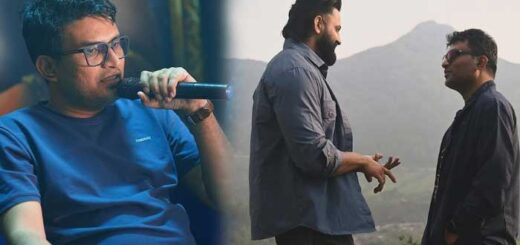The remains of Ammachi Plavu, a huge jackfruit tree is preserved inside the temple premises of the famous Sree Krishna Temple Neyyattinkara, which is regarded as ‘Guruvayur of Thiruvananthapuram District’. Ammachi Plavu – literally means ‘Grandmother Jackfruit Tree’. Ammachi means – very old woman, and plavu means – jackfruit tree. Ammachi Plavu is deeply linked to the history of Travancore kings, and is a spot of attraction of tourists as well, for its heritage and cultural value. Do you know why?

Screen shot of the trunk of the famous Ammachi Plavu, Neyyattinkara
History behind Ammachi Plavu of Neyyattinkara
Mid 1700s – a period when tensions existed between rulers of Travancore and Ettuveettu Pillamaar. Princely state Travancore was then ruled by the most influential king – Anizhamthirunal Marthanda Varma. He was a prince then when ruler of Travancore, Ramavarma took strong actions against “Ettuveettil Pillamar”. Ettuveettil Pillamar turned his enemies and decided to destroy Marthanda Varma and royal family members. Marthanda Varma frequently received life threats from his enemies, and he was forced to live in exile for many years, travelling from one place to another.
Once Prince Marthanda Varma was travelling from Padmanabhapuram Palace to Thiruvananthapuram. Ettuveettil Pillamar got this piece of information and they followed him. Marthanda Varma got informed about it, and he changed his path to Thiruvananthapuram. He took Maharajamuttom route, and short cuts to reach the banks of Neyyar at Neyyattinkara. He reached Palakkadavu (on the banks of Neyyar) where the place was fully blossomed by white Pala flowers. The river was overflowing and he took the help of a boat to cross the river, and hid behind a bush. But by that time, his enemies had almost reached him. He tried to escape through thorny bushes and felt that the hidden place is not safe. He prayed to Lord Padmanabha to help him.

Dead remains of Ammachi Plavu preserved inside the roof
He heard a response from someone in the bush. He saw a shepherd boy looking after his cattle, and got surprised to see him in that lonely place. He asked the boy to suggest a way to escape, and the boy asked him to hide inside the huge hole of a big jackfruit tree near to him. Thus Marthanda Varma escaped from the enemies. Folklore also tells that the boy diverted the direction of Ettuveettil Pillamar to rescue the king. When enemies got out of the place, king came out of the hole.
He called the boy, and could hear him respond. Though King searched the boy later, he couldn’t find him. Instead he found a stone only. He prayed before it and left the place. King believed that boy who helped him to escape was none other than Lord Krishna himself, who disguised as a shepherd. In fact Krishna during his childhood days used to look after cattle. There is a popular belief that an astrologer too told him the same. So, as a mark of gratitude to Lord Krishna who saved his life, Marthanda Varma built a Krishna temple with ‘Unni Kannan’ (childhood Krishna) as its presiding deity. Once he returned to power, he also visited the place and honoured the jackfruit tree covering it with silk cloth. Since then, many believed that Ammachi Plavu owns some divine power.

A close watch of the hole of Ammachi plavu, which is still visible after 250 years
The huge jackfruit tree was also preserved, and over the years Krishna temple turned to be a famous pilgrim place of south Kerala. Now Neyyattinkara Krishna Temple is one of the famous Krishna temples of Kerala, nicknamed as ‘Guruvayur of Thiruvananthapuram District ‘. In the past 10 years, the rush in the temple has multiplied many folds, and a lot of renovations are still going on. Ammachi Plavu, synchronous to this famous Krishna temple and its story have only glorified Unni Kannan over the years, and has played a significant role in increasing the popularity of the temple over the years.
Construction of Sree Krishna temple
The temple was built by Marthanda Varma in the year 1755 in traditional Kerala architecture. The temple was built exactly at the place where King saw the boy. The idol was installed on Anizham star day (birth star of King Marthanda Varma). This day is annually celebrated as ‘Prathishta Dinam’.
As the jackfruit tree saved him like a mother (Amma), the tree achieved the name – Ammachi Plavu and entered the history books of Kerala state. Marthanda Varma later became the most powerful ruler of Travancore state, who himself was an ardent follower of Lord Padmanabha. He ruled Travancore during the period, 1705 – 7 July 1758, till his death. Thus Neyyattinkara Krishna temple was built just three years before the death of this great ruler of Kerala.
After the reign of Marthanda Varma, a custom has been followed by every king of Travancore (Thiruvithankoor – in Malayalam language). Just before the king takes the power of princely state of Travancore, he used to visit Neyyattinkara Krishna temple to seek blessings of Unni kannan and Ammachi Plavu. Then only the royal ceremony takes place.
As per records, till year 1957 Ammachi Plavu blossomed and gave jackfruits also. That means the jackfruit tree was alive for more than a century after it witnessed and became a part of historic events which led to the construction of the famous Krishna temple. But slowly it started degenerating, and the remains were later preserved by Archeology department of Kerala and Travancore Devaswom Board. A roof was also built to preserve the remains of Ammachi Plavu.
Entrance Gopura exhibiting Geethopadesam

Krishna giving Geeta to Arjuna – The entry point of Sri Krishna temple
Entrance Gopura of the temple displays a scene from Bhagavath Geeta, where Lord Krishna offers teachings (Geetopadesam) to Arjuna when he hesitates to fight against his Guru and dear ones. This Gopura has been a centre of attraction of tourists over the years. Similar to Guruvayur temple, soon after the entry gopura, groups of pillars on either sides lead to main entrance of Sree Krishna Temple.

The entry passage to the main temple resembling Guruvayur
On either side of the opening door, we can find Garuda and Angeneya. Balaleela is imprinted on the Gopura door. The mural paintings drawn on the temple walls are excellent remarks of Kerala art, and drawings tell the story of Krishna. It is prohibited to touch the walls, to preserve the painting.
The temple is situated on the banks of Neyyar River, which originates from Agasthyarkoodam. The place also earned the name Neyyattinkara, as it is situated on the banks of river Neyyar. The temple is situated on NH-47 in between railway station and KSRTC bus stand, both 1 km and 0.5 km distant from the temple respectively. Temple is exact 20 kms away from capital city, Thiruvananthapuram.
Palliyara Bhagavathy

Palliyara Bhagavati
When Marthanda Varma built the temple, he also constructed a palace on North-West side of the temple, used as a rest house whenever he visits the place. On one window side of the palace, there is a board titled – Palliyara Bhagavathi. Whenever a person visits here, after bowing before Naga Raga, he also bows before Palliyara Bhagavathi. It is said that whenever king used to visit here, he carried the deity of Bhagavathi along with him. Hence it’s named so. There is no daily worship for Palliyara Bhagavathi. But special poojas are conducted on first Fridays of all Malayalam months, and Kalamezhuthu Paattu, once in every year.
A few words on the presiding deity and major rituals here
‘Unni Kannan’ is the presiding deity of this Krishna temple. Lord Krishna resides here in the form of ‘Navaneetha Krishna Bhavam’, equivalent to the same Bhava of Krishna in the world famous Guruvayur temple. So, to visit this Krishna temple on Janmashtami day is regarded as auspicious. The idol is made of Panchaloga with butter placed on both hands, and it faces west direction. Lord Nagaraja, Lord Ganapati, Lord Subramaniya and Lord Ayyappa are also worshipped here. Ghee is the main offering. Chandana Muzhukaapp, where Krishna’s idol is covered with sandal paste is also an offering here.

Konna Flowers in front of the temple
Palliyunarthal is done at 4 am every day and Nirmalyam at 5 pm. Usha Pooja at 5.30 am, Usha Sheeveli at 6.30 am, Ucha Pooja, Ucha Sheeveli etc are the rituals conducted here every day.
During Navaratri celebrations, three deities – Kumaraswami, Munnuutti Nanga (Kundani Nanga/Manga) and Sarawathi Devi rest one night at this temple on the way to famous Padmanabha Swami temple. The procession starts from the famous Kumaraswami temple near Nagercoil. Ezhuthiruth during Navaratri celebrations are also conducted in the temple.
Annual celebrations fall in the Malayalam month of Meenam (March – April) and there will be grand celebration of 10 days. Kodiyettam is conducted on Uthradam star day of Meenam. It will end on 10thday – Rohini star (Krishna’s birth star). It’s exactly the same day of commence of annual temple festival (Kodiyettam) at Padmanabha Swamy temple, Thiruvananthapuram. The temple is very crowded on the auspicious occasions such as Vishu, Thiruvonam, Janmashtami, and also during Mandalakalam (pilgrim time to Sabarimala).
‘Thrikkai Venna’ is the famous offering of this temple
Childhood Krishna is the presiding deity here. Obviously butter is his favourite. Devotees offer Rasakadali banana alongside butter to Lord Krishna as Thrikkai Venna. Banana with butter given as offering is placed on either hand of the deity and given back to devotees as ‘prasadam’. It’s believed that eating Trikai Venna is a good remedy to all stomach related ailments. Devotees also offer garlands made of basil leaves (Tulsi) and oil/ghee for lamps as offerings.
Popular legend associated with Saint Agasthya
There is a popular legend how the river got the name Neyyar and it’s also connected to the early worship of Lord Krishna here. Agasthyarkoodam is the place where the great saint Agasthya – one among the seven ancient saptarshis did tapas and meditation, and Neyyar – on the banks of which the temple is situated originates from this mountain ranges.

Devotees in front of Ammachi Plavu
As per legends Saint Vilwamangalam Swamy reached Agasthyarkoodam to test Agastha, while he was conducting a yaga at his Ashram. The sights there entertained Vilwamangalam Swamy a lot. He could see pots of ghee placed there for yaga, and the overflown ghee formed a river. Agastha made small balls out of ghee and offered to fire one after the other. Vilwamangalam Swamy witnessed Lord Krishna in childhood form there, accepting ghee by his hands one after the other, offered to yagagni (fire) by the great saint, and eating it.
Vilwamangalam Swamy got extremely pleased with this sight, and on the same night he dreamt Lord Krishna. In the darshan, Lord Krishnan told him that a woman living on the banks of Neyyar will receive an idol of Lord Krishna (at a place where ghee flows in), the river will be later known by the name Neyyar (River of ghee) and the place as Neyyattinkara. As instructed by Lord Krishna, Vilwamangalam Swamy reached here in search of location and a temple was constructed later. As per believes Vilwamangalam installed the idol there.
There is also a legend connected to this woman, who was an ardent believer of Lord Krishna. She used to regularly worship the Krishna idol she got from Neyyar, and used ghee for abhishekam every day. One day she didn’t receive ghee for pooja and she became very sad for this reason. When she cried on the banks of Neyyar, ghee emerged out of fire from homakoodam of saint Agastya at Agasthyarkoodam, and reached Neyyattinkara via Neyyar river, and she used them for abhishekam. Thus Neyyattinkara is believed to be a blessed place.
It’s believed that idol was first installed in Gramam, a nearby village, and hence it’s also known by the name – Grama Kshetram. Bhagavan is also known by the name – Grama Krishnan. Years later the lord blessed King Marthanda Varma at this place, and he made a temple here, says popular legends. It was following a Deva prashnam as suggested by an astrologer he built Krishna temple at this place. It’s to be noted that the temple at Gramam village still exists there. On the 10th day of annual temple festival, the concluding event Aarattu goes to that temple.
This legend is also associated with a devotee of Lord Krishna

A child reading the legend of the temple
Years ago, once a drought came and not even a single drop of water left for performing abhishekam to Lord. Also, no ghee or butter to give as offering. Seeing this situation, an old woman’s eyes were filled with tears. She prayed to Lord Krishna, and very soon Neyyar was filled with water. As per beliefs, since then water started flowing in the river instead of ghee, though colour of river water remains the same. It may be true or not, it is ghee coloured water flowing through the river.
Krishna also gave darshan to that old woman who resided in Krishnapuram. When she came to Neyyar to take a bath, she saw child Krishna playing with cattle in the river water. She revealed to everyone that she got Krishna darshan, and as a result of it, she lost her eye sight. She cried and prayed to Lord Krishna, and he gave her sight of one eye. The curse affected her family too. Since then, for many generations a member always existed in her family who was blind with a single-eye. The family lived near temple for many generations till 60 years ago! As Krishna appeared here playing with cattle, cows are given respect and protected also.
A small note on Potteikkal Thampuram
There is a temple dedicated to Potteikkal Thampuram that shares a close link with Sree Krishnan Kovil, Neyyattinkara. History says Potteikkal Thampuram was a confidential soldier in charge of Marthanda Varma’s safety. He has protected Marthanda Varma’s life in many occasions, most notably the life attacks by Ettuveettil Pillamaar. After Potteikkal Thampuram passed away, he gave darshan to Maharaja and requested him to give a position he actually deserves. So Marthanda Varma built a small temple nearby, and in the evenings Keezhshanti of Neyyattinkara Krishna temple lights lamps at the small temple.
Major landmarks of Neyyattinkara town

Ganapati temple situated at the left side of the entry point of the temple
Neyyattinkara is known for several historic events associated with fights against Divan of Travancore and also freedom struggle movement. In front of Sri Krishna temple, a small Siva temple and Ganapathy temple are also situated. Ganapaty temple has been renovated in the recent times.

Siva Temple in front of Krishna Temple
Along with Chattambi Swamy Memorial and Swadeshabhimani Park, Sri Krishna temple forms the heart of Neyyattinkara town. See a few more landmarks here.

Chattambi Swamy Memorial near to Ganapathy temple
Swadeshabhimani Park is built in memory of famous journalist Swadeshabhimani Ramakrishna Pillai, for his courageous fights against Divan of Travancore in the early 20th century.

Swadeshabhimani Park in memory of Swadeshabhimani Ramakrishna Pillai
Just a few steps away at Alumoodu Junction, there is a famous Nagaraja temple. It’s quite nostalgic to many who studied in nearby schools. It’s named Vettakulam Sri Nagaraja Temple.

A Close shot of Naga idol
The Naga idols are placed just beneath a banyan tree. Banyan tree is called ‘Aal’ or ‘Peraal’ in Malayalam, and as idols are placed beneath the tree, the junction got the name Alumood Junction.

The wide spread banyan tree which gave the name – Alumood Junction to the place
Famous Mele Theruvu Mutharamman Temple is situated near KSRTC Bus stand. Annual temple festival is very grand here, and it’s closely related to temple festivals of Tamil Nadu. One Keezhe Theruvu Mutharamman Temple is also situated in Neyyattinkara, and both temples together celebrate the annual temple festival.

Mele Theruvu Mutharamman Temple
Before I conclude let me add a small bit of information. There is one more Ammachi Plavu at Thrikodithanam Maha Vishnu temple, Changanassery. Before the annual celebrations at the temple, temple priests offer prayers under its knotted trunk.






























This is a very good information you shared here.My hometown is near to Neyyatinkara,Ooruttambalam. Now Iam working at Bangalore.Whenever I go to my home I never miss my chance to see Unnikannan.
This blog helps me to know about Pottekial Thampuran and Palliyara Bhagavathy, which were unknown to me.
Hare Krishnaa
Thanks for your reply. Me too, a native of Neyyattinkara, actually Thirupuram 5 kms away from town. Currently residing in Thrissur, I too never miss to visit the temple whenever I reach Thiruvananthapuram.
Thanks once again.